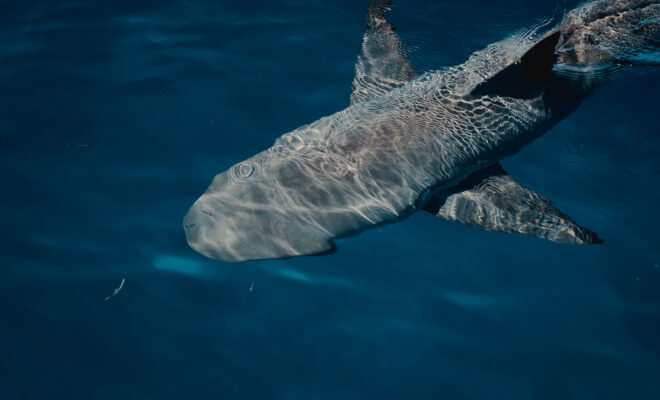By Natascha Wosnick, Shark Researcher – Cape Eleuthera Institute at The Island School
Among the Bahamas’ remarkable inhabitants, the nurse shark, scientifically known as Ginglymostoma cirratum, holds a special place. These coastal-dwelling sharks play a crucial role in the ecosystem by maintaining a balanced food chain, contributing to nutrient cycling, shaping benthic habitats, promoting biodiversity, and providing economic incentives for conservation and awareness efforts. “Ginglymostoma” originates from Greek, meaning hinged mouth, while “cirratum” stems from Latin, referring to the shark’s curled ringlets. The nurse shark is easily recognizable by its brownish coloration. These solitary nocturnal creatures spend their nights scouring the ocean floor for food, but they form large sedentary groups during the day.
During the summer months, visitors and residents often report unusual activity among nurse sharks, seen splashing or seemingly struggling in shallow waters. Don’t be alarmed, what you’re likely observing is nurse sharks engaging in their mating rituals.
Nurse Shark Reproduction
The Bahamas holds significant importance for nurse shark conservation, as it has been a sanctuary for all sharks since 2011, thus protecting their mating season. This period, occurring from late June to the end of July is a fascinating sight to behold. During the beginning of the reproductive period, female nurse sharks are often not ready to mate, so they form pairs or smaller groups to protect themselves from the males. The males can get aggressive and insistent, sometimes harassing lone females. To further protect themselves, the females bury their pectoral fins in the sand, making it difficult for the males to bite them and attempt forced copulation.
As the females become more receptive, you might observe large groups of up to 10 sharks, comprising both males and females, in shallow waters. This phase is critical as it allows couples to form based on preferences that are not fully understood yet. After this period, the pairs separate from the group, and you can witness them engaging in copulation, often lasting several days. This extended mating time increases the chances of successful pregnancies. Following copulation, the couple separates again, and the female may choose another male to mate with, employing yet another strategy to enhance her chances of becoming pregnant.
As copulation occurs in the shallows, you might notice the dorsal and caudal fins protruding from the water. The pair often remains still for extended periods, occasionally swimming short distances with their fins still exposed. So, if you see brown-colored fins sticking out of the water in shallow regions, you’re likely witnessing a mating event. To copulate, males bite the pectoral fin of females, then turn them onto their stomachs to proceed with fertilization. This is when you may see or hear splashes in the water, and sometimes the couple may curl up or position themselves on their backs. Female nurse sharks carry their pups for six months and can give birth to up to 29 pups each mating season. The newborns, measuring about 1 foot in length, are a distinctive brown color adorned with scattered black spots. Following the mating season, adult nurse sharks return to deeper waters, while the young ones seek refuge in creeks or patch reefs, increasing their chances of survival and growth.
Preserving The Species
Preserving the species in the Bahamas is vital for maintaining robust populations and ensuring the health of our oceans as they regulate prey populations, maintain biodiversity, and control the spread of diseases that can affect their prey. Sadly, nurse sharks face global threats, especially from commercial fishing targeting their fins for the Asian market, meat consumption in countries like Brazil, leather for bags and shoes, and jaws as souvenirs. Thus, protecting nurse sharks, particularly during their mating season, is critical to safeguarding the species from extinction worldwide.
If you encounter nurse sharks in very shallow waters, it’s essential to maintain a safe distance, as they might become more aggressive during this time. If possible, take photographs from a distance and share them with our research team via email at natascha.wosnick@islanschool.org. Old photos are equally valuable as they help us build a database on the species’ mating season, contributing data to inform nurse shark behavior, reproduction and conservation. Make sure you also send us the time (month and year), and location where the photos were taken. If you are interested in becoming a citizen scientist and joining our initiative to monitor nurse shark mating sites in the Bahamas, please don’t hesitate to contact us. Together, we can collect valuable scientific data, working to protect these magnificent creatures and preserve the beauty of our oceans.
Nurse sharks are seen resting in shallow water with their fins out of the water during the mating season. Photo credit: Alexa Hoffman.
A female shark is seen floating belly up, being held by the male using her pectoral fin during a copulation event recorded in Kemps Creek, South Eleuthera, Bahamas. Photo credit: Natascha Wosnick.
During copulation recorded in June 2023 in South Eleuthera, (1) the male utilizes a biting strategy to immobilize the female. (2) Subsequently, he positions her on her stomach, likely to optimize the fertilization process. (3) The male then inserts his copulatory organ into the female. Photo credit: Natascha Wosnick.
